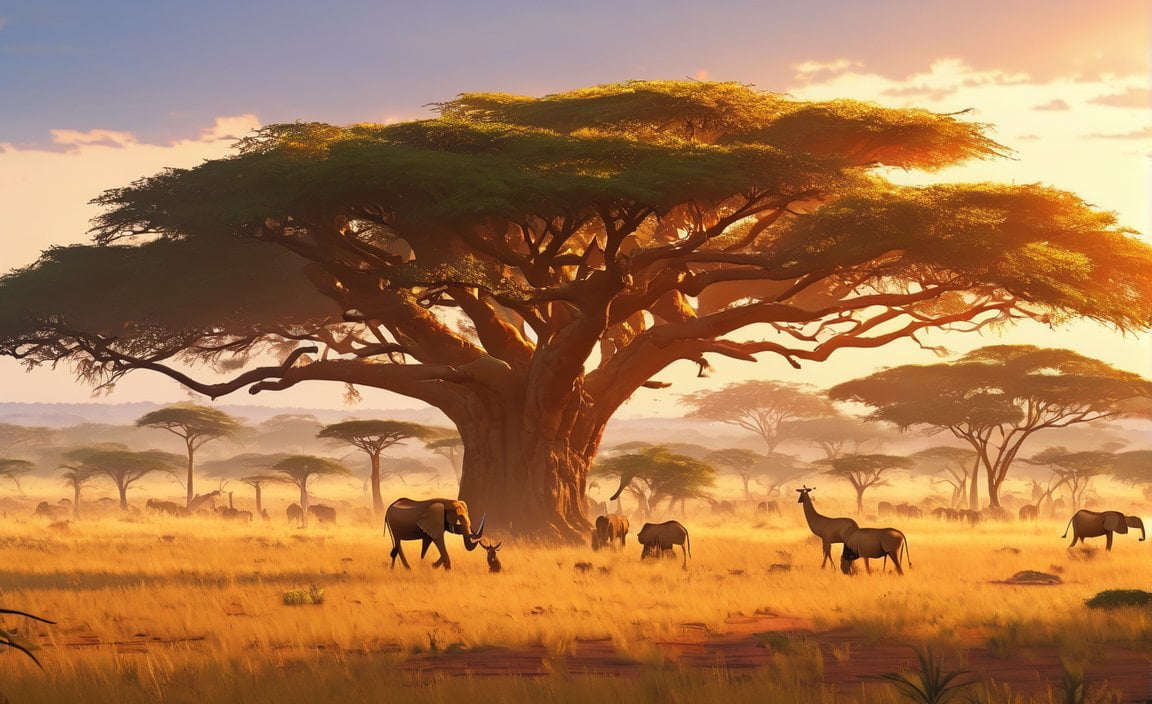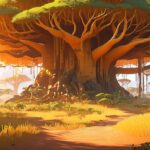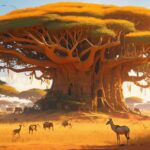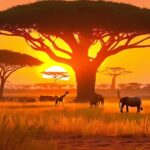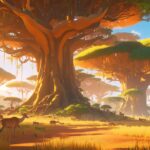Discover 10 Captivating Facts About the African Savanna. Step into the awe-inspiring world of the African savanna, where an abundance of wildlife and stunning landscapes await. From the majestic lions and towering giraffes to the vast grasslands and shimmering waterholes, this ecosystem is an enchanting tapestry of life. Join us on a journey of exploration as we reveal ten fascinating facts about this remarkable habitat that will leave you in awe of its beauty and complexity. Prepare to be amazed by the wonders that await in the heart of Africa’s savannas.
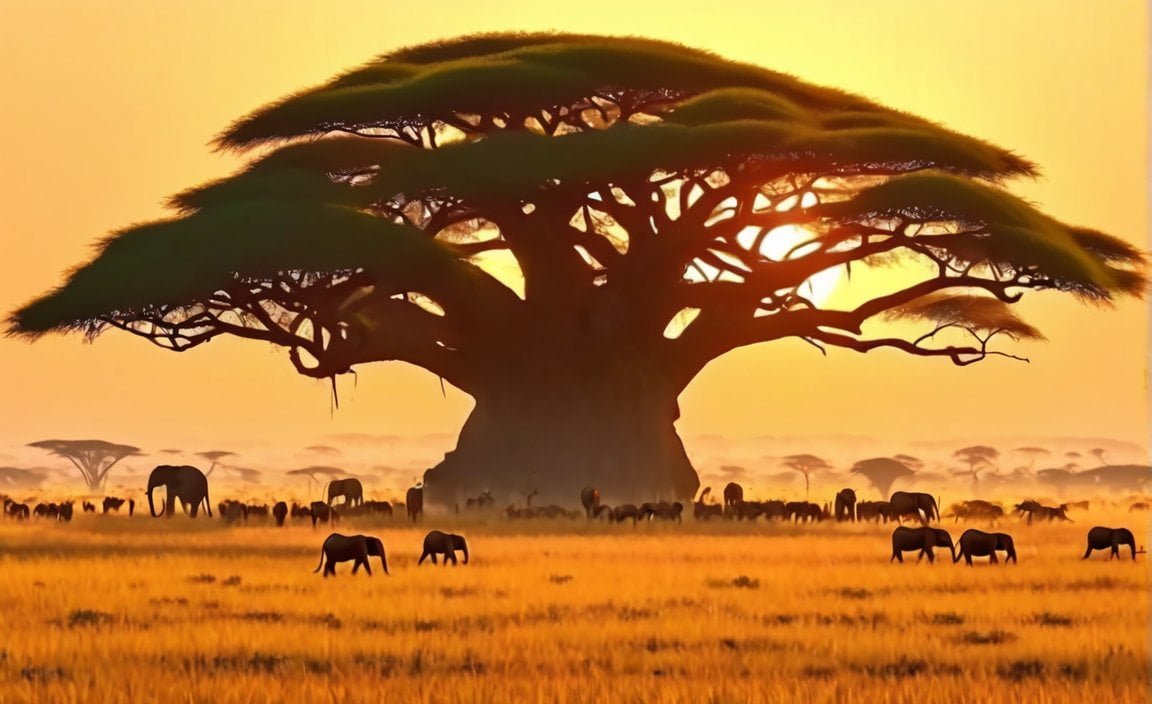
Key Takeaways:
- Grazing animals, such as wildebeests, migrate in search of green grass.
- The weather in the African Savanna is hot year-round.
- Only a few drought-resistant trees, like eucalyptus, acacia, and the baobab tree, grow in this biome.
- During wildfires, birds and large animals seek safety, while small burrowing mammals dig deep into the Earth.
- The Savanna has distinct wet and dry seasons.
- Similar grassland ecosystems exist in Australia, South America, and India.
- The African Savanna is home to a diverse range of animal species.
- The Savanna also boasts unique plant adaptations.
- Fires are common in the African Savanna.
- Indigenous cultures call the Savanna home.
To learn more about the African Savanna, visit the following sources:
– Easy Science for Kids: The Savanna
– Facts.net: Savanna Facts
Note: This article was generated using AI and multiple online sources. Please refer to the original source information provided in the “Learn more” links for further verification and more in-depth knowledge.
10 Facts About the African Savanna
Welcome to the captivating world of the African savanna! This unique ecosystem is teeming with life and holds many intriguing secrets. Join me as we uncover 10 fascinating facts about this incredible landscape.
Fact 1: A Haven for Migrating Grazers
The African savanna is the stage for one of the world’s greatest wildlife spectacles. Each year, vast herds of grazers, such as wildebeests, zebras, and gazelles, embark on an epic migration in search of green grass and water. Witnessing this awe-inspiring event is a testament to the remarkable adaptability and resilience of these animals[^1^].
Fact 2: Year-round Heat
When you step into the African savanna, be prepared for the embrace of the sun. This ecosystem experiences hot weather throughout the year. The constant heat ensures the survival of specially adapted plants and animals that have evolved to thrive in these arid conditions[^1^].
Fact 3: An Oasis of Resilient Trees
In the savanna’s harsh environment, only a few species of drought-resistant trees can withstand the relentless sun and sporadic rainfall. Among them are the majestic acacia, eucalyptus, and the iconic baobab tree, known as the “Tree of Life.” These trees serve as vital sources of food and shelter for the diverse wildlife that inhabits the savanna[^1^].
Fact 4: The Dance of Survival
Picture this: a wildfire sweeps through the savanna, engulfing the grasses and trees. In the face of danger, the larger animals and birds swiftly flee to find safety. At the same time, small burrowing mammals, like meerkats and ground squirrels, use their instinctive skills to escape by digging deep into the safety of the Earth. The intricate dance of survival in the face of adversity is a testament to the resilience of savanna’s inhabitants[^1^].
Fact 5: A World of Contrasting Seasons
The African savanna experiences distinct wet and dry seasons, each bringing its own unique set of challenges and opportunities. These seasonal shifts shape the behavior and adaptations of the wildlife that calls the savanna home. From the lush green expanses of the wet season to the golden-hued grasslands of the dry season, the savanna is a paradise of contrasts throughout the year[^1^].
Fact 6: A Global Presence
While the African savanna is undoubtedly iconic, it is not confined to one continent. Similar grassland ecosystems can be found in various parts of the world, including Australia, South America, and India. Each savanna, though unique, shares similar characteristics and supports a diverse array of plant and animal life[^1^].
Fact 7: A Tapestry of Animal Life
The African savanna is a treasure trove of biodiversity. It supports an astonishing array of wildlife, from the majestic African elephant and the stealthy lion to the graceful giraffe and the elusive cheetah. Each species has intricately adapted to survive and thrive amidst the challenges of the savanna, creating a harmonious tapestry of life[^1^].
Fact 8: A Haven of Unique Plant Adaptations
Surviving in the savanna requires special adaptations, and the plants here have evolved ingenious strategies to withstand the extremes. Some have developed long taproots to access deep water reserves, while others have thick, waxy leaves to minimize water loss. These remarkable plant adaptations ensure the survival of both flora and fauna in this dynamic ecosystem[^1^].
Fact 9: A Landscape Shaped by Fire
Fire is an integral and frequent occurrence in the African savanna. These flames, often caused by lightning strikes or human activities, play a vital role in maintaining the ecosystem’s health. They clear away old vegetation, promote the growth of fresh grasses, and provide opportunities for various plant species to regenerate. The savanna has adapted to embrace and withstand these recurring fires[^1^].
Fact 10: A Cultural Melting Pot
Beyond its breathtaking natural beauty, the African savanna is also home to diverse indigenous cultures that have a deep connection with the land. These communities have rich traditions, folklore, and a profound understanding of the delicate balance between human and wildlife coexistence. Their presence adds another layer of richness and significance to the splendor of the savanna[^1^].
Ready to Explore the African Savanna?
Now that you’ve discovered these captivating facts, imagine the beauty and wonder that awaits you in the African savanna. From the epic migrations to the harmonious coexistence of diverse species, this remarkable ecosystem is a testament to the power of nature’s intricate designs. The African savanna is a place where life thrives against all odds, inspiring awe and sparking a deep appreciation for our natural world.
To delve deeper into the wonders of the African savanna, I recommend visiting the following sources for additional information and insights:
- Easy Science for Kids: The Savanna
- Facts.net: Savanna Facts
Remember, this article is just the beginning of your journey into the enchanting realm of the African savanna. By exploring further, you will uncover countless stories and experiences that will further enrich your understanding and appreciation of this magnificent ecosystem.
Note: This article was generated using AI and multiple online sources. For in-depth knowledge and verification, please refer to the original sources provided in the “Learn more” links.
Here are some fascinating facts about various topics that will surely pique your interest:
10 Facts About Biomes: Discover the incredible diversity and unique characteristics that make biomes such fascinating ecosystems.
10 Facts About Condensation: Dive into the intriguing world of condensation and learn how it plays a crucial role in our everyday lives.
10 Facts About Marine Biology: Uncover the wonders of marine life and explore the fascinating field of marine biology.
10 Facts About Marine Life: Delve into the captivating realm of marine life and discover the remarkable creatures that inhabit our oceans.
10 Facts About Ocean Life: Immerse yourself in the mysteries of ocean life as you explore the incredible diversity and adaptations of marine species.
10 Facts About Temperate Deciduous Forest: Venture into the enchanting world of temperate deciduous forests and witness the beauty of changing seasons.
10 Facts About Temperate Forests: Journey through the vast expanses of temperate forests and learn about the rich diversity of flora and fauna.
10 Facts About Temperate Rainforest: Embark on an awe-inspiring adventure into temperate rainforests and discover the lush abundance of life within these unique ecosystems.
10 Facts About The Marine Life: Plunge into the depths of our oceans and be amazed by the astonishing variety of marine life that exists beneath the surface.
10 Facts About The Ocean Animals: Explore the captivating world of ocean animals and learn about the incredible adaptations that enable them to thrive in their aquatic habitats.
10 Facts About The Tropical Savanna: Embark on a thrilling safari through the tropical savanna and uncover the fascinating wildlife and dynamic ecosystems of these vast grasslands.
Fact #2: The savanna experiences distinct wet and dry seasons, which influence the behavior and survival strategies of its inhabitants.
The African savanna is a dynamic ecosystem that goes through distinct wet and dry seasons, each with its own unique impact on the behavior and survival strategies of the animals and plants that call it home. Let’s explore this fascinating aspect of the savanna and uncover how its inhabitants adapt to these seasonal changes.
Wet and Dry Seasons: A Cycle of Change
In the savanna, the wet and dry seasons mark a cycle of change that greatly influences life on the plains. The wet season, also known as summer, is characterized by heavy rainfall that nourishes the land and triggers a burst of growth and activity. On the other hand, the dry season, or winter, brings drought and scarcity of water, challenging the survival of its inhabitants.
During the wet season, the savanna comes alive with vibrant greenery and abundant water sources. The savanna receives all its rain during the summer, which allows for the growth of lush grasses and provides ample water for both plants and animals. This abundance of resources attracts various species, leading to an incredible concentration of wildlife in certain areas.
Conversely, the dry season poses a significant challenge for both flora and fauna. With limited rainfall and water sources, plants wither and die, and some streams and rivers dry up completely. As a result, the animals of the savanna must migrate over long distances in search of food and water, which often leads to dramatic and awe-inspiring movements across the landscape.
The Impact on Behavior and Survival Strategies
The distinct wet and dry seasons have shaped the behavior and survival strategies of the savanna’s inhabitants over countless generations. These adaptations allow them to not only survive but thrive in this dynamic environment.
During the wet season, the abundance of water and vegetation creates ideal conditions for grazing herbivores. The savanna becomes a paradise for migrating grazers like wildebeests, zebras, and gazelles, attracted by the lush grasses that provide them with essential nutrients. It’s truly a sight to behold as vast herds traverse the landscape, following the available resources in a constant search for sustenance.
On the other hand, predators such as lions, cheetahs, and hyenas must adapt their hunting strategies to these seasonal changes. The abundance of prey during the wet season increases competition, pushing predators to develop more intricate and cooperative hunting techniques. This not only ensures their survival but also contributes to the delicate balance of the savanna ecosystem.
During the dry season, survival becomes more challenging. Many of the savanna’s herbivores have evolved unique migration patterns, moving to areas with better access to water and food. These long and arduous journeys are essential for their survival and require them to navigate long distances, often facing predators, exhaustion, and unpredictable obstacles along the way.
Key Takeaways:
- The African savanna experiences distinct wet and dry seasons that greatly influence the behavior and survival strategies of its inhabitants.
- The wet season brings heavy rainfall, lush growth, and an abundance of resources, attracting a concentration of wildlife.
- The dry season, characterized by drought and scarcity of water, challenges the survival of both flora and fauna.
- Herbivores migrate during the dry season in search of food and water, while predators must adapt their hunting strategies to cope with changes in prey distribution.
- These adaptations and migrations contribute to the resilience and balance of the savanna ecosystem.
Citations:
– AtOnce. Unbelievable Facts About the Savanna: Ultimate Guide 2024
– Conserve Energy Future. Savanna Biome: Location, Climate, Temperature, Soil, Plants and Animals
Fact #3: The grasses of the savanna have significant adaptations to survive wildfires, grazing, and drought.
In the vast African savanna, the grasses that cover the landscape have evolved remarkable adaptations to withstand the challenges of wildfires, grazing, and drought. These adaptations are crucial for the survival of the entire ecosystem and play a vital role in maintaining the balance between plants, animals, and the environment.
How Grasses Survive in the Savanna
1. Dormancy and Rapid Growth: Savanna grasses have an incredible ability to go dormant during dry periods and then grow rapidly when the rains arrive. This survival strategy allows them to conserve energy and moisture during droughts, and then take advantage of the favorable conditions when water becomes available again.
2. Underground Water Storage: To combat the arid conditions of the savanna, some grasses have developed organs that store water, such as bulbs or corms. These underground reservoirs provide a valuable source of hydration during long periods of drought, ensuring the grasses can survive even when water is scarce.
3. Fire Resistant Adaptations: Wildfires are a natural occurrence in the savanna biome, and grasses have evolved mechanisms to cope with these frequent burn events. Some grasses have thick, fire-resistant stems that allow them to withstand the intense heat and flames. Additionally, their ability to quickly regenerate after a fire ensures the continuity of the grassland ecosystem.
4. Grazing Defense Mechanisms: Grazing animals, such as wildebeests, zebras, and antelopes, are common in the African savanna. To protect themselves from being overgrazed, grasses have developed various defense mechanisms. Some grasses produce toxins or develop spines and tough coverings, making them less palatable or even harmful to herbivores. This ensures that the grasses can continue to thrive and provide vital food sources for the herbivores that depend on them.
5. Deep Root Systems: The grasses of the savanna have adapted to tap moisture from deeper underground. They develop extensive root systems, reaching deep into the soil in search of water. This adaptation allows them to access water sources that are beyond the reach of shallow-rooted plants, enabling their survival during the dry season.
In summary, the grasses of the African savanna have extraordinary adaptations that enable them to withstand the harsh conditions of wildfires, grazing, and drought. Through dormancy, rapid growth, underground water storage, fire-resistant traits, grazing defense mechanisms, and deep root systems, these grasses ensure the resilience and survival of the entire ecosystem.
Key Takeaways:
- Savanna grasses exhibit dormancy during dry periods and grow rapidly when rains return.
- Some grasses have organs that store water, such as bulbs or corms, to survive prolonged droughts.
- Grasses have developed fire-resistant adaptations to withstand frequent wildfires in the savanna.
- Defense mechanisms like toxins, spines, and tough coverings protect grasses from overgrazing by herbivores.
- Deep root systems allow grasses to tap into water sources deeper underground, enhancing their drought tolerance.
Sources:
– Ask A Biologist: Savanna Plant Adaptations
– Britannica: Savanna
Fact #4: The African Savanna Plays a Crucial Role in Global Carbon Storage and Climate Regulation.
The African savanna is not only a stunning and diverse landscape but also a key player in global carbon storage and climate regulation. Let’s delve into the fascinating details that highlight its significance in these critical processes.
Influencing the Global Carbon Cycle
The expansive African savanna, stretching across 50% of the continent, encompasses various ecosystems, including the iconic Serengeti grasslands and the unique Miombo woodlands[^1^]. These diverse landscapes contribute significantly to the global carbon cycle, acting as both carbon sinks and sources.
Vegetation and soil processes in the savanna play a vital role in storing and releasing carbon. However, fire-driven carbon efflux and the impact on tree cover and soil carbon have led to the assumption that savannas store less carbon than their potential[^1^]. Ongoing research is deepening our understanding of these complex dynamics.
Beyond Carbon: A Biocultural Heritage
The importance of African savannas extends beyond their role in carbon storage. These landscapes harbor a rich biodiversity, supporting a myriad of wildlife species and providing vital habitat for elephants, giraffes, lions, and cheetahs[^2^]. The remarkable diversity of the savanna also attracts wildlife tourism, bolstering local economies and conservation efforts.
Apart from their biodiversity, African savannas contribute to the livelihoods of millions of people. They sustain water availability and provide grazing and browsing opportunities for communities deeply connected to the land[^2^]. The cultural practices and traditions that have evolved alongside these ecosystems make them true biocultural treasures.
Rising CO2 Levels: Impact on Savanna Dynamics
The African savanna is not immune to the effects of increasing carbon dioxide levels in the atmosphere. This rise in CO2 favors the growth of trees over grasslands in many savanna ecosystems, including those in Southern Africa[^3^]. This phenomenon has brought about significant changes in the landscape, altering vegetation dynamics and potentially affecting the delicate balance of species interactions.
Studies have shed light on the surprising role of CO2 in influencing the vegetation dynamics of savanna ecosystems. As our understanding of climate change deepens, it is crucial to consider these dynamics while formulating conservation and land management strategies for savannas.
Conservation Challenges and Future Research
Despite their ecological and cultural significance, African savannas face numerous conservation challenges. A lack of knowledge and understanding of their ecological dynamics poses a significant obstacle to effective conservation efforts[^4^]. However, initiatives aimed at tree planting and raising awareness about the value of savanna ecosystems are gaining recognition.
Ongoing research endeavors are focused on expanding our understanding of the role of savannas, addressing conservation issues, and formulating effective strategies for their protection. These efforts are essential for fostering sustainability, resilience, and balance within the savanna ecosystem.
Key Takeaways:
- The African savanna is a crucial player in global carbon storage and climate regulation, contributing to the global carbon cycle through vegetation and soil processes.
- Beyond carbon, savannas hold immense biocultural value, serving as habitat for diverse wildlife and supporting the livelihoods of millions of people.
- Rising CO2 levels are impacting savanna dynamics, favoring tree growth over grasslands and prompting substantial changes.
- Conservation challenges, such as insufficient knowledge and understanding, necessitate ongoing research and initiatives to enhance conservation efforts within savanna landscapes.
[^1^]: Nature – “Limited increases in savanna carbon stocks over decades of fire”
[^2^]: Climate and Forests UNDP – “The Vital Role of African Savanna Landscapes in Global Climate Action”
[^3^]: Yale E360 – “The Surprising Role of CO2 in Changes on the African Savanna”
[^4^]: Science.gov – “African savanna ecosystem”
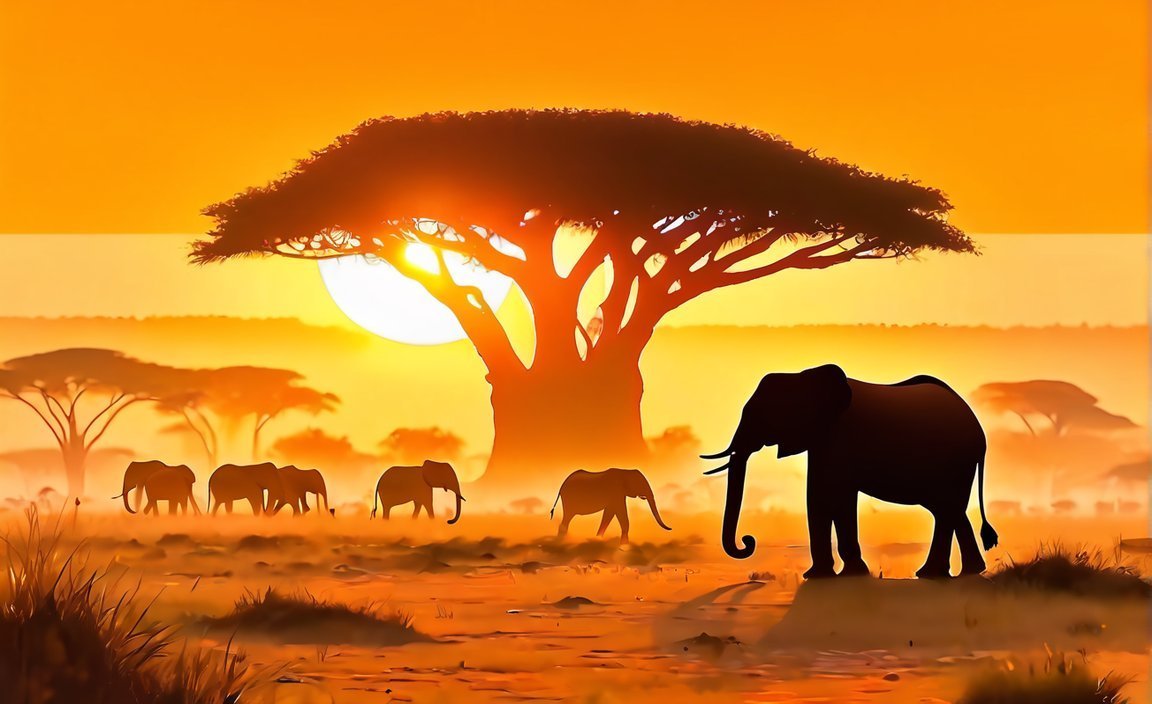
FAQ
Q1: What is the climate like in the African savanna?
A1: The African savanna experiences a hot climate year-round, with distinct wet and dry seasons. During the wet season, there is heavy rainfall, while the dry season is marked by drought and scarcity of water.
Q2: What types of animals can be found in the African savanna?
A2: The African savanna is home to a diverse range of animal species, including iconic animals such as lions, elephants, giraffes, and zebras. It is also inhabited by numerous other species, including wildebeests, antelopes, hyenas, and various bird species.
Q3: How do plants in the African savanna adapt to survive the harsh conditions?
A3: Plants in the African savanna have developed various adaptations to survive the dry conditions and periodic fires. Some plants have organs that store water, like bulbs or corms, while others have thick coverings or spines to protect themselves from being eaten. Savanna trees are usually deciduous, losing their leaves during the dry season.
Q4: What role do wildfires play in the African savanna ecosystem?
A4: Wildfires are common in the African savanna and play a crucial role in maintaining the grassy plains. They clear away dead plant material, stimulate the growth of grasses, and create open spaces for herbivores to graze. Certain plant species in the savanna have even evolved to rely on fire for their survival.
Q5: Are there any indigenous cultures that call the African savanna home?
A5: Yes, the African savanna is home to various indigenous cultures that have deep connections to the land. These cultures have developed unique traditions and practices that are intertwined with the savanna ecosystem, highlighting the importance of the biocultural heritage of the region.
- China II Review: Delicious Food & Speedy Service - April 17, 2025
- Understand Virginia’s Flag: History & Debate - April 17, 2025
- Explore Long Island’s Map: Unique Regions & Insights - April 17, 2025
